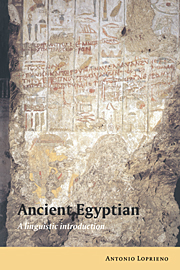Book contents
- Frontmatter
- Contents
- Preface
- Major Chronological Divisions of Egyptian History
- 1 The language of Ancient Egypt
- 2 Egyptian graphemics
- 3 Egyptian phonology
- 4 Elements of historical morphology
- 5 Nominal syntax
- 6 Adverbial and pseudoverbal syntax
- 7 Verbal syntax
- Epilogue
- Notes
- References
- Index of passages
- Index of morphemes
- Index of lexemes
- Index of topics
Epilogue
Published online by Cambridge University Press: 08 December 2009
- Frontmatter
- Contents
- Preface
- Major Chronological Divisions of Egyptian History
- 1 The language of Ancient Egypt
- 2 Egyptian graphemics
- 3 Egyptian phonology
- 4 Elements of historical morphology
- 5 Nominal syntax
- 6 Adverbial and pseudoverbal syntax
- 7 Verbal syntax
- Epilogue
- Notes
- References
- Index of passages
- Index of morphemes
- Index of lexemes
- Index of topics
Summary
Throughout this book, we have observed the extraordinary vitality of a dead language. Although one of the latest languages to have been deciphered and analyzed from a linguistic perspective, Ancient Egyptian proves to be an ideal field for linguistic investigation. Its visually most appealing feature, the hieroglyphic script in which the language was mainly expressed, is a complex but flexible pictographic system suited to convey the phonological, morphological, and lexical oppositions of the language as perceived by its users. By the same token, the history of the system and of its manual varieties (Hieratic and Demotic) offers the opportunity to observe the various functional pressures to which it was exposed: while preserving a certain degree of immutability during three millennia, the hieroglyphic script expanded or restricted its phonological and semantic potential depending both on the social composition of the scribal elite and on the cultural nature of the texts. Finally, the interface between changes in the religious Weltanschauung from the emergence of Hellenism to the rise of Christianity on the one hand and the “alphabetic revolution” which caused Egyptian to be rendered in a Greek-derived script (Coptic) provides a comprehensive basis for the study of the relationship between language, writing system, and cultural ideology: firstly, in Egypt and elsewhere, it is the script, rather than the language, that becomes a symbol of “heathendom,” of the old religious order which a new revealed religion aims to overcome; secondly, the alphabetic system is not an inevitable outcome of a writing system which privileges the phonological level: although it possessed from the beginning a set of monoconsonantal signs, the hieroglyphic system never departed from its complex fusion of semagrams and phonograms, but on the contrary expanded in its final stages the number and the functional role of its iconic elements.
- Type
- Chapter
- Information
- Ancient EgyptianA Linguistic Introduction, pp. 237 - 239Publisher: Cambridge University PressPrint publication year: 1995



